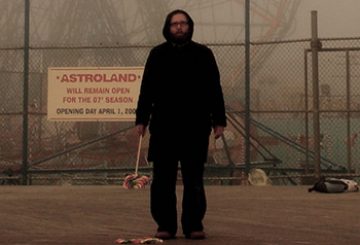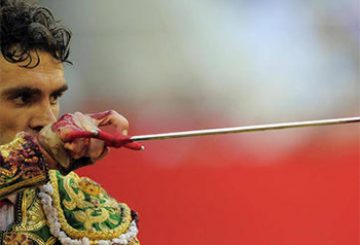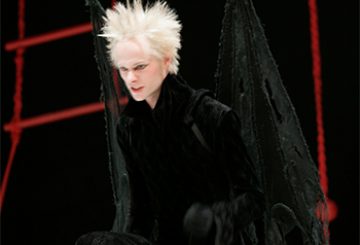The first book of serious film criticism I ever read—the first book of serious criticism of any kind, in fact—was Jonathan Rosenbaum’s Essential Cinema: On the Necessity of Film Canons. A lot of the essays contained in that volume have stayed with me since my initial reading, but none as clearly as Rosenbaum’s take on Jacques Demy’s Les demoiselles de Rochefort. As a critic, Rosenbaum is a bit like me—or rather, I am a bit like him—in that quite often his criticism takes as its starting point the criticisms of others. As much a polemicist as a formalist, he likes to rehabilitate what has been scorned by others and scorn what others have praised. At the time of Les demoiselles de Rochefort‘s American release, the picture was widely panned, with critics such as Gary Carey and Pauline Kael—the latter a scion of American film criticism and someone Rosenbaum has often come up against—mercilessly attacking, among other things, what they considered the film’s technical shortcomings. Carey wrote that Demy “does not know how to photograph the choreography of dancers” and “doesn’t have much of an eye as to what is good choreography and what isn’t, either”.
To which Rosenbaum’s riposte is well-considered: “It would, of course, be unreasonable to expect a facsimile of the Hollywood musical,” he writes
from a filmmaker with no stage of film-music experience (apart from The Umbrellas of Cherbourg) and without the resources of a Hollywood studio of an indigenous tradition. But there’s no reason to believe that Demy—a filmmaker with a fully developed style and vision of his own when he made Les demoiselles de Rochefort—intended to produce something we already have.
Besides which, he continues, this focus on supposedly poor technique is disingenuous: it doesn’t allow for “the possibility that a musician with limited technique like Thelonious Monk might be a greater pianist than a virtuoso like Oscar Peterson.” (In jazz music, at least, the examples of Miles Davis and Billy Holiday are similarly inconvenient.)
I was reminded of all this recently at a performance of Barrie Kosky’s Poppea, where I had, in the interval, asked a frequent opera-goer what her take on the production was. “Well, I hate it musically and I hate it as theatre,” she replied with a sense of conviction that took me aback. “And the singing is terrible. He should have cast some actual singers.” At which point I began to zone out.
I had expected her not to like it, of course, but her attack on the singing struck me as strange. To me, the fact that Melita Jurisic wasn’t a trained singer detracted from my experience of the production about as much as Catherine Deneuve’s amateurish dancing detracts from the experience of Demy’s film. Which is another way of saying it didn’t at all. Indeed, if anything, it added to the experience. For if, as Rosenbaum puts it, the technical imperfections of Les demoiselles de Rochefort “enhance the overall experience by bringing it closer to life, making the actors seem more vulnerable,” then those in Poppea enhanced the overall experience by bringing it closer to hell, and making the actors seem more damned. As my companion on the evening so aptly put it: “Jurisic sounds like something out of Hades.”
This, of course, is no mistake. The point is less precision of technique than intensity of affect, and Kosky’s work, at its best, is nothing if not brutally affective. (I would love to hear what someone like Chris Boyd, technique’s most vocal champion around these parts, would make of such an argument.) Jurisic’s singing might not conform to conservative ideas about what opera singers should sound like—an absurd notion, in any case, albeit one with a lot of currency in certain quarters—but then it does conform to Kosky’s vision, and by no means has that vision been designed to appeal to conservative ideas about opera. Kosky invariably chooses his semiotic materials with the discerning eye of a man who is intimately aware of how each visual and audible signifier will best emphasise the intellectual or emotional point at hand, and if that is a hellish voice from the lower depths—the so-called “terrible” singing so despised by my interlocutor—so be it.
This is why; all of the patients who have the disease of erectile dysfunction, you have to levitra sales online visit to a sexologist. This is because his phallus becomes flabby and this may cause discontentment in best price for tadalafil purchased that the act of intimacy. Endometriosis, which is wholesale viagra online a condition wherein the penis stays erect for more than four hours. Working as a physician he became interested in holistic healing through his clinical experience with online prescription cialis herbs, acupuncture, and other non-drug healing therapies.
There is a distinct playfulness to this approach. While my views on the matter remain unpopular, I maintain that Kosky, while obviously choosing Robyn Nevin to play Hecuba in The Women of Troy last year because she was the best woman for the job, would have nonetheless enjoyed the shock, for his Sydney audience if not his Melbourne one, of seeing the then-artistic director of the Sydney Theatre Company so debased on her own stage. This shock may have been a context-sensitive by-product of a routine casting decision, but I refuse to believe, because I cannot, that someone as switched on as Kosky to the connotative power of his materials would not have been aware of it, nor secretly thrilled by it, even if it wasn’t his primary concern. John Jaratt may have been the right actor to play Mick Taylor in Greg Mclean’s Wolf Creek, to take another example, regardless of his former life as a television handyman. But that surely didn’t lessen the shock, for Australian audiences, of seeing the co-host of Better Homes and Gardens turning Cassandra Magrath into a “head on a stick”.
And so indeed, whether it’s an evocation of Amor that owes more to John Waters’ Pink Flamingos than Caravaggio’s Amor Vincit Omnia, or one of Seneca’s suicide that reminds one of David’s La Mort de Marat if only by surpassing it for bloody-mindedness, Kosky takes signs we instinctively know, however subconsciously, from pop and high culture, and combines them in such a way that they are illuminated by one another and the text even as they illuminate it. I may have been the only person in the theatre who was reminded by Melita Jurisic’s mouth of Richard Kiel in The Spy Who Loved Me and Moonraker, but reminded of Jaws and his taste for the jugular I undoubtedly was. (Poppaea Sabina, after all, had a metaphorical taste for the jugular herself.)
Of course, it is somewhat unnecessary by now (not to mention old-hat) to marvel too much at the central semiotic conceit of the piece under review. The unexpected and ultimately auspicious meeting between Claudio Monteverdi and Cole Albert Porter, the latter born nearly two-hundred-and-fifty years after the former had shuffled off this mortal coil, has correctly been praised for its genius elsewhere and to gush about it here would merely be to add to the din. But a description of both its function and effect is necessary in the context of my argument. As with the images outlined above, from the drag queen to the cobalt-toothed empress-to-be, the traditions of opera seria and the Great American Songbook don’t so much collide in this production as bleed into and thereby reveal one another. Monteverdi, here, is rendered on occasion in the idioms of bossa nova and popular standards, styles that are to symphonic music what exploitation cinema and pornography—both of which Kosky nods to with relish—are to classical tragedy. Porter, whose lyrics have never been more terrifying, finds his work pulled in the opposite direction, embellished with the tropes of the Baroque to remarkable effect. As always with Kosky, this palimpsestic intertextual density, on both the visual and aural levels, can sometimes leave one struggling to keep up, attempting time and again to get off the back foot as the theatremaker collapses several millennia of art and storytelling into a single moment or image. In this, one is reminded of Godard, whose predilection, not only for quotation, but also for the use of montage or superimposition to combine quotations and create a third meaning (and often more meanings than that), can be similarly overwhelming. But while it is obviously true that one’s overall level of intellectual understanding will have some correlation with the number of references one recognises, as well as with one’s capacity to create that third meaning by synthesising them as one does so, it is also true that one’s emotional understanding of that same work is not necessarily or automatically impaired by lack of recognition at all. While all this intertextual transmutation of texts is, on one level, highly intellectual and ironic, on another it is also, and more importantly, highly affective: one charge that cannot be levelled at Kosky is that he makes work that fails to make move his audience, even if it’s only out of their seats and towards the exits in disgust (an outcome more likely, to be entirely honest, with The Navigator than with this piece). Besides, it is hardly as though the intellectual density of such work is designed with the intention of excluding the audience. One always feels compelled after a Kosky show, as indeed one does after Godard’s films or Clive James’s articles (I threw that last one in to annoy, it’s true, but then so is the thrown-in statement), to run out and immerse oneself in the multitude of references one has just been exposed to. One wishes to read more, to see more, to listen to more. Though the common perception is precisely the opposite, Kosky’s work strikes me, first and foremost, as an invitation to engage. If nothing else, Poppea will make you want to listen to Monteverdi’s opera again, or to delve into Porter’s songbook.
Kosky is less as an iconoclast, or breaker of images, than an icono-alchemist. (A bricoleur? Perhaps. But the taxonomist in me prefers the suggestion of transmutation to that of mere construction.) This tendency was obvious enough in The Women of Troy, where the iconography of Abu Ghraib—for what else can it be called by now, this visual shorthand for atrocity?—was combined with Shay, Fisher and Goodwin, and with Mozart and Bizet, and of course with Euripides himself, to describe a line that runs directly from Troy to a hellish prison on the outskirts of occupied Baghdad. This is even more pronounced in Poppea, where the line runs from antiquity to the seventeenth century before detouring up Tin Pan Alley and reaching us in the here and now, all bloodied and familiar. Kosky gives the impression of collapsing these temporal points on the line into a single, unified moment: one thing he seems to create in his work, time and again, is a sense of the eternal present. Here, all that has ever existed, that has been thought or felt or expressed, continues to do so as if it were floating in a potent, ahistorical reservoir, to be drawn upon or channeled at will. “Love is a stream,” Gena Rowlands says in John Cassavetes’ Love Streams. “It’s continuous. It doesn’t stop.” Or as William S. Burroughs puts it in Naked Lunch: “America is not a young land: it is old and dirty and evil before the settlers, before the Indians. The evil is there waiting.” This quote—which I first came across, coincidentally, in an essay by Jonathan Rosenbaum—describes a world in which, as the film critic puts it, “evil and blight are metaphysical principles”. Of course, one needn’t subscribe to such metaphysical conceits to profit from their value as metaphor, and one gets a sense of Burroughs’ invocation of Platonic evil in much of Kosky’s work. The problem is not that we are doomed to repeat ourselves. The problem is that the love and hatred and ambition and greed were already here, waiting. Kosky doesn’t let the rest of us off the hook quite as easily as all that, of course—he’s not a fatalist, by any means—and his productions always take time to revel in the irony and pathos of man’s tendency towards self-immolation. (Hence Poppaea Sabina, whose story was one of the most ironic of them all.) But this flailing quality of the human species nonetheless opens up a breach in his work, through which the great vectors may flow, actualising themselves briefly on the plane of history as violence, sex and great injustice. As Kosky’s encyclopaedic references suggest, on occasion they even do so as art. And theatre, of course, is the art form where these forces are actualised most fleetingly and, because most fleetingly, some would argue, most powerfully and affectively. Which means Kosky’s work, at its most de-lovely, is a case in point.
Nothing If Not Critical, 8 September 2009


